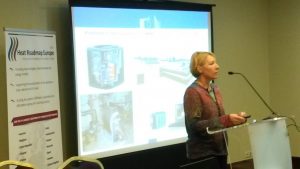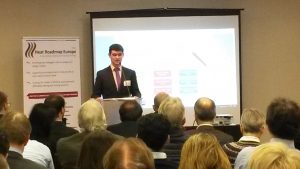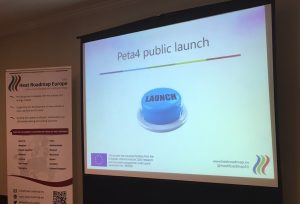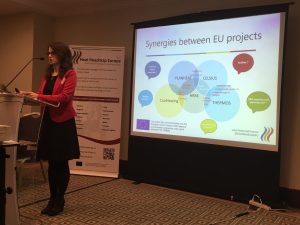Dynamic workshop marks Pan-European Thermal Atlas launch
On the occasion of the Heat Roadmap Europe (HRE) workshop in Brussels on Tuesday 7th March, over 80 participants from all over Europe learned about the different types of heating and cooling demand and supply, the exact heating and cooling potential and where it is located. Representatives from academia, associations, the municipal sector, NGOs and the private sector gathered together for the afternoon to consider the how HRE4 results can support with solutions to decarbonise the heating sector on the local, national and European scale.
 The event kicked off with words of welcome from Eva Hoos, DG Energy, European Commission and Paul Voss, Euroheat & Power who both highlighted the importance of science-based tools for decarbonising of the heating/cooling sector. “It will be of great help to have comprehensive package like Heat Roadmap Europe 4 – from which to take inspiration and select tools that are adapted for guiding on this big journey towards 2030 framework.” said Hoos.
The event kicked off with words of welcome from Eva Hoos, DG Energy, European Commission and Paul Voss, Euroheat & Power who both highlighted the importance of science-based tools for decarbonising of the heating/cooling sector. “It will be of great help to have comprehensive package like Heat Roadmap Europe 4 – from which to take inspiration and select tools that are adapted for guiding on this big journey towards 2030 framework.” said Hoos.

David Connolly, HRE Project Coordinator, from Aalborg University went on to provide an introduction and overview of Heat Roadmap Europe 4. “HRE will help save money, carbon emissions, and energy consumption. For years, power plants, industry, and waste incinerators all across Europe have been throwing away enormous quantities of heat and for the most part, this has gone unnoticed.” explained Connolly to the audience. “With HRE, policymakers, planners, suppliers and researchers can make informed decisions, for example by identifying hotspots with Peta4, so that they can replace the energy created by fossil fuel boilers with this excess heat instead. Cities currently spend millions on natural gas to heat their buildings and now they can meet their EU energy targets while also cutting costs for consumers.”

In order to create comprehensive heating and cooling strategies in HRE, an in-depth profile of the heating and cooling sector is required and this was presented next. Tobias Fleiter of the Fraunhofer ISI revealed the detailed profiles compiled over the last months, along with TEP Energy, Utrecht University and Armines, which calculate a complete heating and cooling end-use energy balance for all EU countries for 2015, and which distinguishes major end-uses such as space heating or process heating as well as temperature levels for process heat. The results of this profiling allow for detailed analyses of individual countries and sectors as well as cross-country comparisons.
 The long-awaited Peta4 launch then got underway, with background presentations by Bernd Möller of Flensburg University and Urban Persson of Halmstad University, who provided technical context to the upgraded version of the first ever interactive maps of the heating and cooling demand, efficiency and supply in Europe. The newly launched Pan-European Thermal Atlas (Peta4) revealed itself to be the perfect tool for European governments of all levels, but also for businesses, consultants, academia and energy enthusiasts to quickly and accurately assess thermal resources and thermal demand in a region.
The long-awaited Peta4 launch then got underway, with background presentations by Bernd Möller of Flensburg University and Urban Persson of Halmstad University, who provided technical context to the upgraded version of the first ever interactive maps of the heating and cooling demand, efficiency and supply in Europe. The newly launched Pan-European Thermal Atlas (Peta4) revealed itself to be the perfect tool for European governments of all levels, but also for businesses, consultants, academia and energy enthusiasts to quickly and accurately assess thermal resources and thermal demand in a region.
Read more, explore, and watch the Peta4 video tutorial here.
 Discussions wrapped up with questions from the audience and a panel discussion with related EU heating and cooling projects, to explore synergies and potential for unfolding project results. The “sister projects” present were CELSIUS project represented by Katarina Folland Gothenburg City), PLANHEAT represented by Stefano Barberis (D’ Appolonia, THERMOS represented by Joshua Thumim (Centre for Sustainable Energy) and CoolHeating represented by Tomislav Puksec (University of Zagreb).
Discussions wrapped up with questions from the audience and a panel discussion with related EU heating and cooling projects, to explore synergies and potential for unfolding project results. The “sister projects” present were CELSIUS project represented by Katarina Folland Gothenburg City), PLANHEAT represented by Stefano Barberis (D’ Appolonia, THERMOS represented by Joshua Thumim (Centre for Sustainable Energy) and CoolHeating represented by Tomislav Puksec (University of Zagreb).
The event wrapped up with a celebratory toast to the launch of the Peta4.
Profiling Europe’s heating and cooling demand
Learn more about HRE4 with the videos from the HRE4 Workshop that took place in Brussels, on the 7th of March 2017. Here you can find all of the four videos for this workshop.